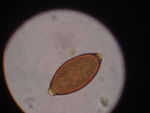Difference between revisions of "Trichuris vulpis"
m (Text replace - "Category:To_Do_-_NickJ" to "") |
|||
| Line 1: | Line 1: | ||
| − | {{ | + | {{OpenPagesTop}} |
| − | |||
{{Taxobox | {{Taxobox | ||
|name =''Trichuris vulpis'' | |name =''Trichuris vulpis'' | ||
| Line 29: | Line 28: | ||
''T. vulpis'' can be found in many places throughout the world. The longevity of the eggs is the major feature of the spread of these worms as they can survive in the environment for a number of years under suitable conditions. As light infections can be carried asymptomatically, host animals can spread the disease readily. Older dogs tend to have a higher burden than younger dogs due to accumulation over the life of the animal. | ''T. vulpis'' can be found in many places throughout the world. The longevity of the eggs is the major feature of the spread of these worms as they can survive in the environment for a number of years under suitable conditions. As light infections can be carried asymptomatically, host animals can spread the disease readily. Older dogs tend to have a higher burden than younger dogs due to accumulation over the life of the animal. | ||
| − | = | + | {{Learning |
| − | + | |literature search = [http://www.cabdirect.org/search.html?q=title:(%22Trichuris+vulpis%22)+ ''Trichuris vulpis'' publications] | |
| − | + | }} | |
| − | |||
| − | |||
| − | |||
| + | {{OpenPages}} | ||
[[Category:Trichinelloidea]] | [[Category:Trichinelloidea]] | ||
[[Category:Dog_Nematodes]] | [[Category:Dog_Nematodes]] | ||
| − | |||
| − | |||
Revision as of 13:08, 20 July 2012
| Trichuris vulpis | |
|---|---|
| Kingdom | Animalia |
| Phylum | Nematoda |
| Class | Enopla |
| Sub-class | Dorylaimia |
| Order | Trichocephalida |
| Super-family | Trichinelloidea |
| Family | Trichuridae |
| Genus | Trichuris |
| Species | T. vulpis |
Overview
Thrichuris vulpisis a typical whipworm in appearance and life cycle. The worms have a pre-patent period of 3 months before eggs are found in feaces, though they are not always present and several samples may be necessary to confirm infection. It inhabits the large intestine and ceacum of dogs and less often foxes and cats worldwide. Commonly seen in the caecum, but rarely in large enough quantities to cause clinical signs, most notably diarrhoea in dogs.
Identification
Adults are between 4.5 and 8cm long, slender and white coloured. The anterior end is long and filamentous becoming broader towards the posterior. The males tail is coiled and has a single spicule, used for reproduction, in a protrusible sheath. Eggs are distinctive lemon shaped with a thick shell and bioperculated having plugs at each pole. The eggs appear yellow/brown colour in the faeces.
Epidemiology
T. vulpis can be found in many places throughout the world. The longevity of the eggs is the major feature of the spread of these worms as they can survive in the environment for a number of years under suitable conditions. As light infections can be carried asymptomatically, host animals can spread the disease readily. Older dogs tend to have a higher burden than younger dogs due to accumulation over the life of the animal.
| Trichuris vulpis Learning Resources | |
|---|---|
 Search for recent publications via CAB Abstract (CABI log in required) |
Trichuris vulpis publications |
Error in widget FBRecommend: unable to write file /var/www/wikivet.net/extensions/Widgets/compiled_templates/wrt693970bd6ea1c3_24400633 Error in widget google+: unable to write file /var/www/wikivet.net/extensions/Widgets/compiled_templates/wrt693970bd793a10_44010901 Error in widget TwitterTweet: unable to write file /var/www/wikivet.net/extensions/Widgets/compiled_templates/wrt693970bd7fd600_51709267
|
| WikiVet® Introduction - Help WikiVet - Report a Problem |
